
Chapter 1: Corporate Innovation Under Pressure
In 2025, corporate innovation is caught in a high-stakes paradox: economic uncertainty is up, budgets are down, yet the pressure to innovate is skyrocketing—driven by AI, platform models, and faster tech adoption. Despite CEOs naming "New Business" a top priority, most innovation teams face stagnating resources and limited support. Only 3% of corporations are truly innovation-ready. At GlassDollar, we’re seeing a leaner, ROI-focused approach take shape - one built for impact under pressure.
This article marks Chapter 1 of our soon-to-be-released Impact Study Volume II on how corporate innovation is evolving in 2025.
Much has been written about the turbulence shaking the global economy in 2025. And just as much has been written about “how to do corporate innovation right”, especially by consultancies and venture studios, each trying to post-rationalize their own preferred vehicle and service offering. We know this pattern well, because we’ve been part of it ourselves. When GlassDollar was founded back in 2019, we started out primarily as a service business.
We always had the ambition to build a product, but we began by delivering services. And like many other “venture providers,” our messaging naturally aligned with what supported our offering. We preached what we sold, and what our customers, mostly corporate innovation units, wanted to hear. That meant emphasizing the value of structured pilot programs, strategy decks filled with corporate venturing jargon, and hands-on startup scouting services.
Looking back, these programs were often overengineered, layered with checkpoints, templates, processes, and innovation jargon that made startup collaboration feel more complex than it needed to be. In many cases, this complexity was welcomed – no, even expected – by corporate innovation teams themselves. With innovation often under scrutiny internally, structure helped justify their role as the middleman between business units and the startup ecosystem, as well as their expertise and headcount.
The result? A well-intentioned but self-reinforcing loop of overcomplication on both sides. In hindsight, we were unintentionally reinforcing the same dynamics we now help teams overcome. But over time, our perspective on corporate innovation evolved. And so did our business. We gradually pivoted from a service provider into a software company.
Today, GlassDollar is an all-in-one, end-to-end platform (check out our vcLOS), designed to help corporate teams not only source startup solutions but also test them in real-world conditions, and most importantly, adopt and roll them out at scale across the organization. We still support onboarding with a team of experts, but our goal is to get teams up and running fast, not stay embedded.
This shift didn’t just unlock scale for us. It made our clients more autonomous. With the right tools in place, many companies have empowered not just their innovation teams, but also their business units, to source and test startup solutions independently, at least for more tactical or near-term challenges. In some cases, our software has made it possible to drive innovation without needing a separate innovation team at all. It also solved what is arguably the biggest conflict of interest in corporate innovation.
- We no longer need to present innovation as more complex than it actually is.
- We’re not incentivized to stretch projects or defend a single model.
- Instead, we focus on enabling innovation managers and business units to build the internal capability to scout, test, and adopt the best existing technology solutions for their real business needs.
In short: self-service technology, not PowerPoint slides and workshops.
Through this approach, we’ve equipped hundreds of innovation professionals across dozens of corporate teams with the foundational corporate innovation tech stack, spanning industries, geographies, and organizational structures. That gives us a uniquely objective view into how innovation is actually being done on the ground – what’s working, what’s not, and where teams are struggling to move forward.
- So what’s the current sentiment inside corporate innovation teams?
- How are innovation budgets being impacted by all the macro noise?
- How are innovation strategies adjusting in response?
- And most importantly, what’s the most effective way to master corporate innovation in 2025 and beyond?
These are just some of the questions we’ve been discussing intensively with our clients over the past weeks and months, complemented by external research and proprietary data. The latter includes the insights we first published in our 2023 Impact of Venture Clienting report, which we’ve since expanded with fresh perspectives and new datasets.
This foundation allows us to bring evidence-based clarity to a space often dominated by noise and narrative. Together, these inputs give us a unique view into the frontline reality of corporate innovation in 2025. With this new Corporate Innovation “Reality Check” series, we’re now sharing these insights more broadly with the corporate innovation community.
And we’re starting with what we believe is the most defining characteristic of the current moment: Corporate innovation in 2025 is caught in a high-stakes paradox.
The High-Stakes Paradox in Corporate Innovation
On one side, economic uncertainty is reaching record highs.
Fueled by geopolitical instability, rising protectionism, and unpredictably shifting trade policies, corporations, especially across Europe, are growing noticeably more cautious.
In early 2025, economic uncertainty even surpassed the levels seen during the peak of the Covid-19 crisis, a period most of us considered a once-in-a-lifetime economic outlier.
.png)
The result?
A sharp decline in corporate optimism, tighter innovation budgets, and a growing instinct to retreat to what is known and safe. In times of uncertainty, corporate exploration becomes harder to justify. Risk tolerance drops, and bold innovation initiatives are often the first to be scaled back. Innovation leaders today are navigating an environment where even incremental bets must fight harder for internal funding and executive backing.
Yet on the other side of the paradox, the pressure to innovate has never been greater.
The speed of technological advancement continues to accelerate exponentially, reshaping industries faster than many corporations can adapt.
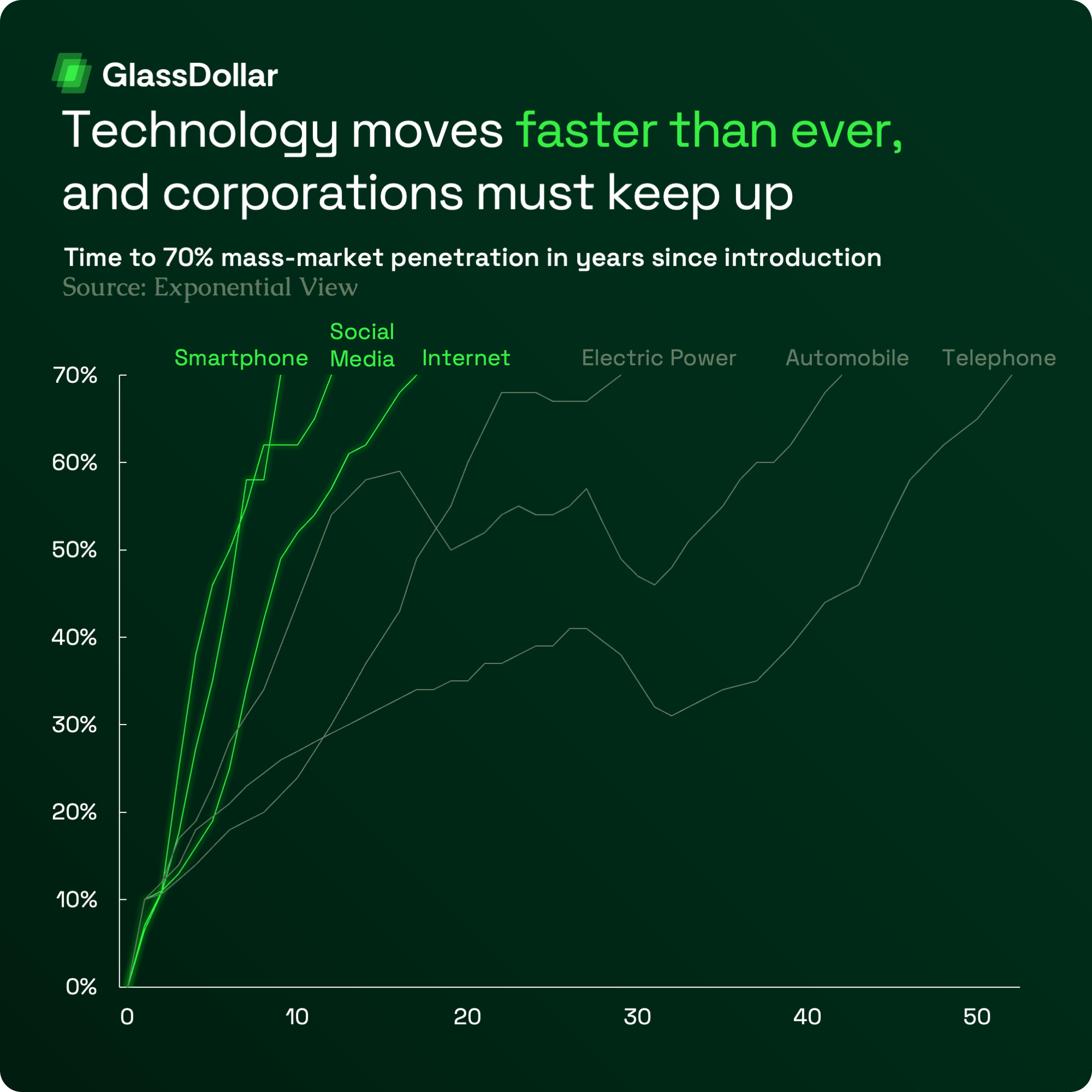
This acceleration is particularly visible in the digital space. Technologies and platforms that once took years to reach mass adoption are now scaling in months. But more fundamentally, 2025 marks a new era in technological disruption: Generative AI, another general-purpose technology similar to electricity or the internet, is in full swing to impact every sector, every function, and every business model. Case in point: ChatGPT reached 100 million users in less than two months after launch, setting a new benchmark for mass adoption speed and showcasing how quickly new technologies and tools can now reshape consumer and corporate behavior.

Given the chart above, it’s easy to assume this acceleration applies mainly to consumer-facing applications. But that misses the bigger picture.
Breakthrough platforms, especially in the context of AI, like ChatGPT, aren’t just end-user tools. They’ve become the foundational infrastructure for a new wave of B2B innovation. Their open architecture has enabled thousands of startups to build vertical, enterprise-focused solutions on top, spanning everything from legal automation to customer service, marketing, supply chain optimization, and internal tooling.
No surprise, then, that nearly 90% of all equity funding into AI startups in recent years (more than $90 billion in 2024 alone) has gone to companies with B2B business models. Enterprise demand is skyrocketing. Corporations across every sector are racing to integrate AI into their operations, products, and service offerings, fueled by this growing ecosystem of next-gen B2B technology startups.
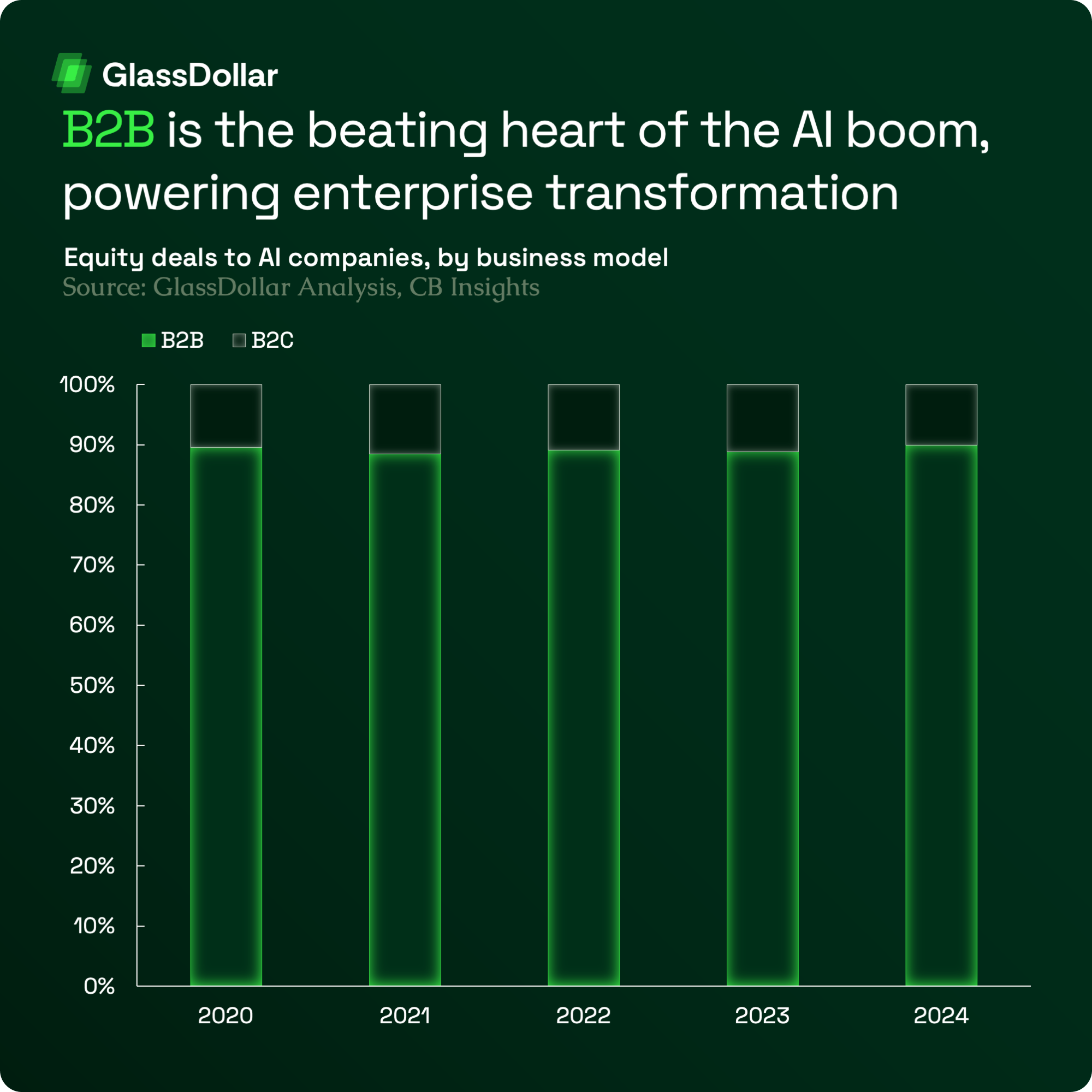
The lesson for corporate innovation is as urgent as it is clear: no matter their size, market position, or industry, corporations must now think and operate like technology companies. More than that, they must act like platform companies, able to plug into what’s being developed at an ever-accelerating pace.
So in a world moving at this speed, standing still is not a strategy; it is a slow-motion exit.
History has shown what happens to companies that try to “wait it out.” They decline. The average lifespan of companies in the S&P 500, the index of America’s 500 largest listed firms, has fallen from more than 30 years in the late 1960s to less than 20 years today, a reminder that competitive advantage is increasingly fleeting in the modern economy.

Reinvention Rises to the Top of the CEO Agenda
With this unprecedented need for speed and reinvention, the next key question is: how have corporations responded in 2025 so far?
On the bright side, company leaders have recognized that standing still is no longer an option. Reinvention has become a survival imperative, at least in boardroom discussions.
Case in point: According to McKinsey’s latest Global Survey, 7 out of 10 CEOs now rank New Business creation, meaning the development of new products, services, and business models, as their number one strategic priority for 2025. In contrast, defensive cost-cutting moves like divestments or restructuring initiatives score significantly lower.
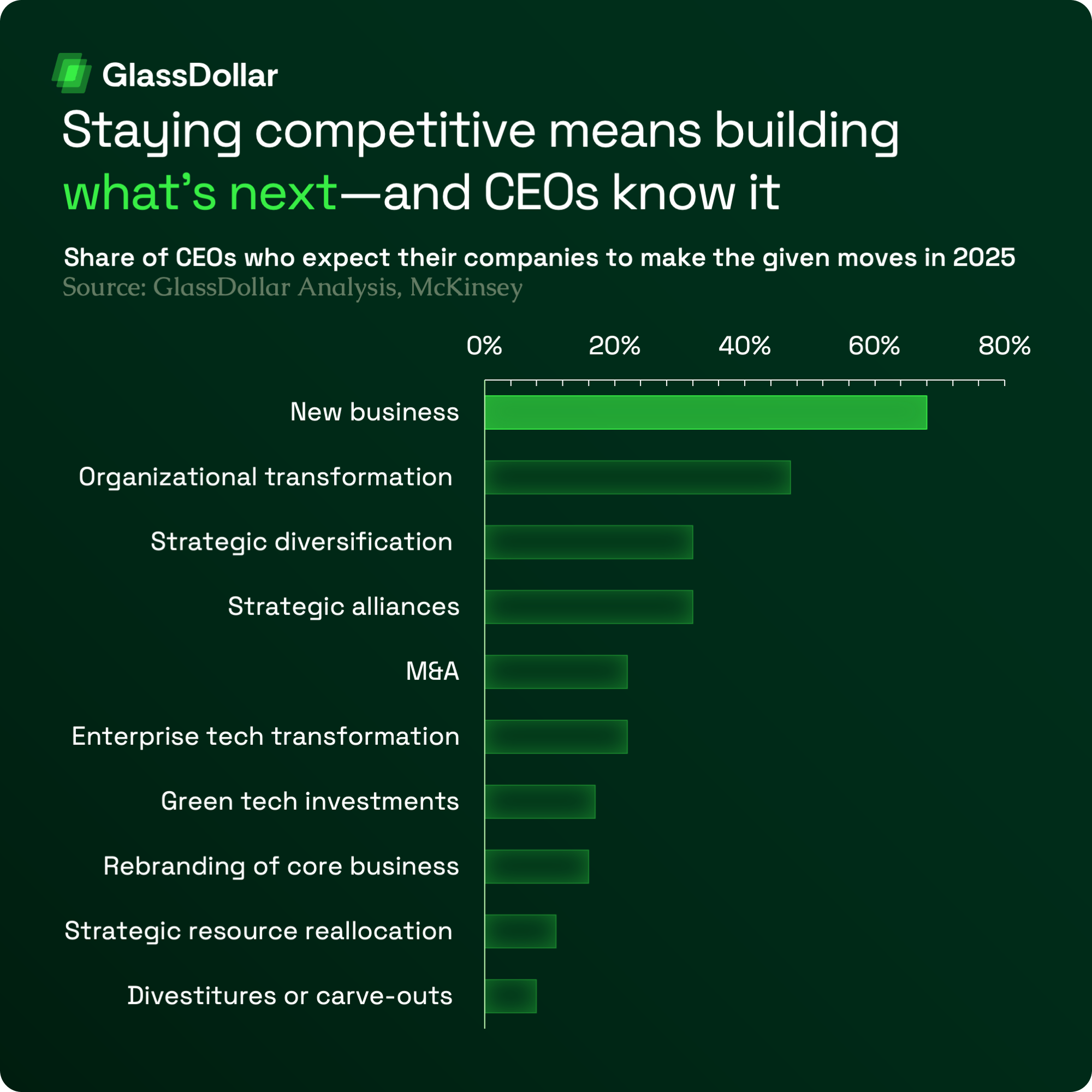
The Innovation Gap Is Getting Harder to Ignore
Despite CEOs claiming to prioritize innovation and New Business creation, the reality on the ground tells a different story.
Take a recent example from the German corporate innovation scene: BMW and Daimler’s sale of FreeNow – once a flagship Horizon 3 venture and poster child for “New Business” innovation – was a sobering reminder that even high-profile innovation bets are not immune to financial pressure.
In many of our frontline conversations with innovation leaders, we hear a recurring theme:
“Innovation is a board-level mantra, but not a budget line.”
Words don’t always translate into investment, and the numbers back this up.
A look at corporate innovation budgets in 2025 reveals a clear trend: resources for innovation are not growing. Quite the opposite. Research confirms that nearly three out of four innovation budgets are stagnating or declining this year.
Note: This excludes classical R&D budgets, which are typically treated separately, especially in hardware-heavy industries.
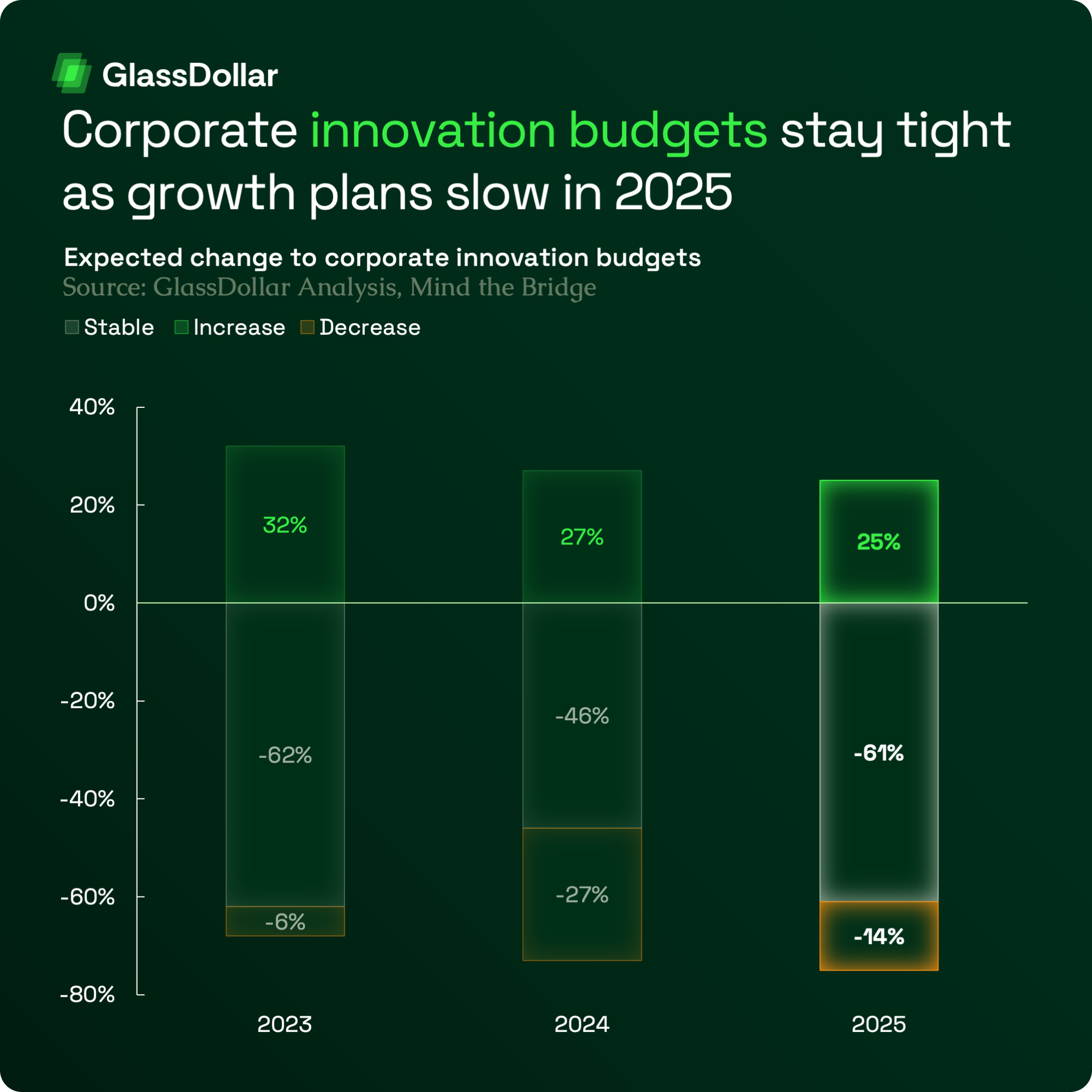
While there are legitimate questions around how effectively these budgets have been used in the past – with some critics, including our own CEO Fabian Dudek, calling out instances of “innovation theater” that may have contributed to tighter budget scrutiny – it’s still undeniable that pushing innovation forward with fewer resources is a much tougher game.
So what’s causing tighter innovation budgets?
Cost pressure has become the number one obstacle.
- Nearly half of all corporations cite limited financial resources as their primary challenge for innovation in 2025, according to BCG.
- The same research highlights an even more sobering insight: only 3% of corporates today can be considered truly “innovation ready” (that definition reflects not just available budget, but a mix of other constraints like top-level support, organizational structure, and internal capabilities).
By any measure, that’s a sobering outlook.
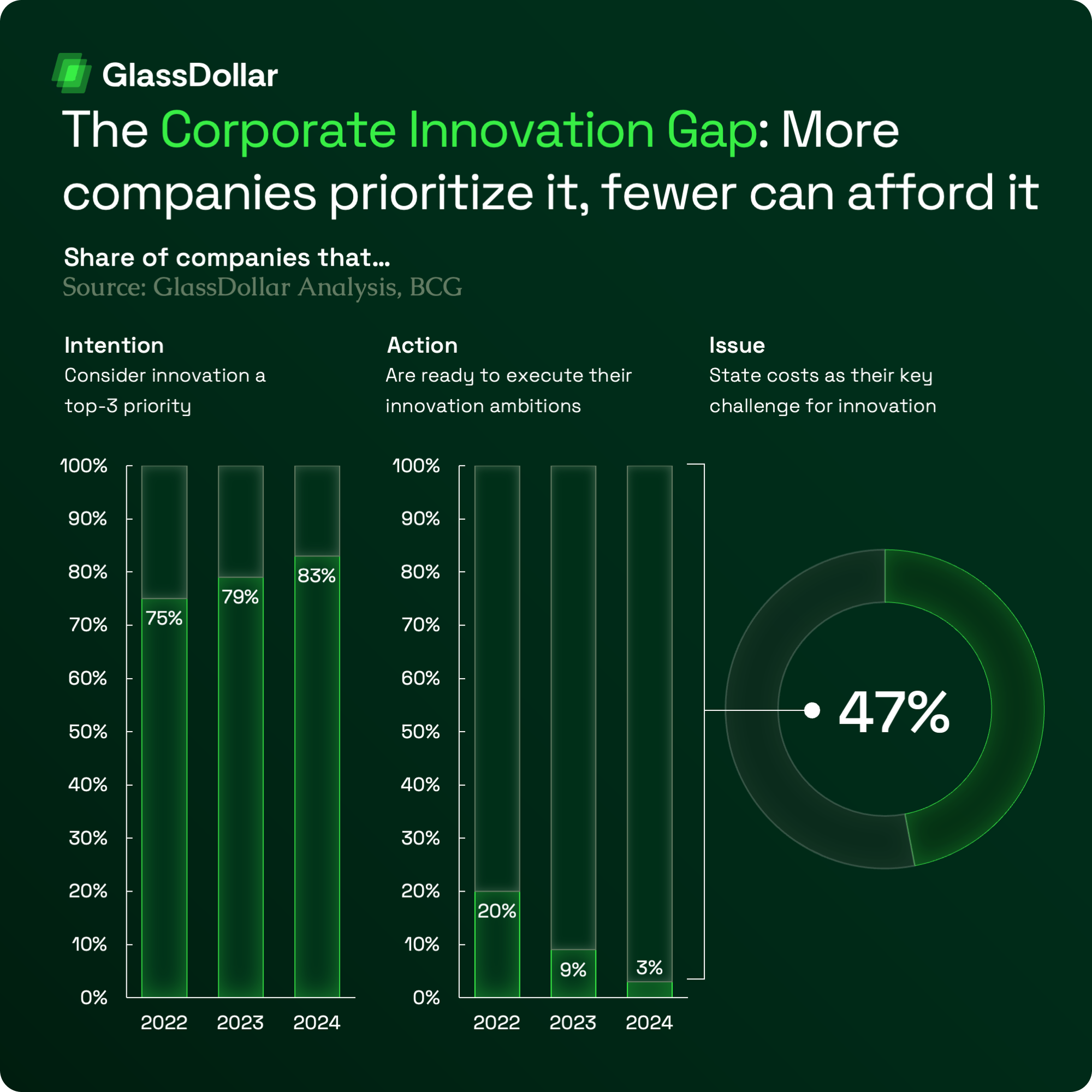
This gap between ambition and execution is arguably the defining characteristic of corporate innovation in 2025. It’s also something we encounter daily at GlassDollar, through hundreds of conversations with innovation teams across industries.
- Most corporates know what needs to be done.
- Many are led by highly motivated innovation professionals.
- But they still struggle to secure the time, funding, and internal support needed to move from idea to execution.
But there’s something else we’re seeing: adaptation.
As pressure increases and budgets tighten, a new approach to corporate innovation is quietly emerging. It may not carry the same hype or sex appeal as past innovation cycles, but it’s more grounded in business reality, favoring shorter timelines, leaner structures, and a higher likelihood of measurable ROI.
And as history has shown, some of the most resilient companies and breakthrough models are often built in precisely these kinds of high-pressure environments.
How does this new model work, and what does it mean for the future of corporate innovation?
That’s what we’ll explore in our next Reality Check.
So stay tuned.





